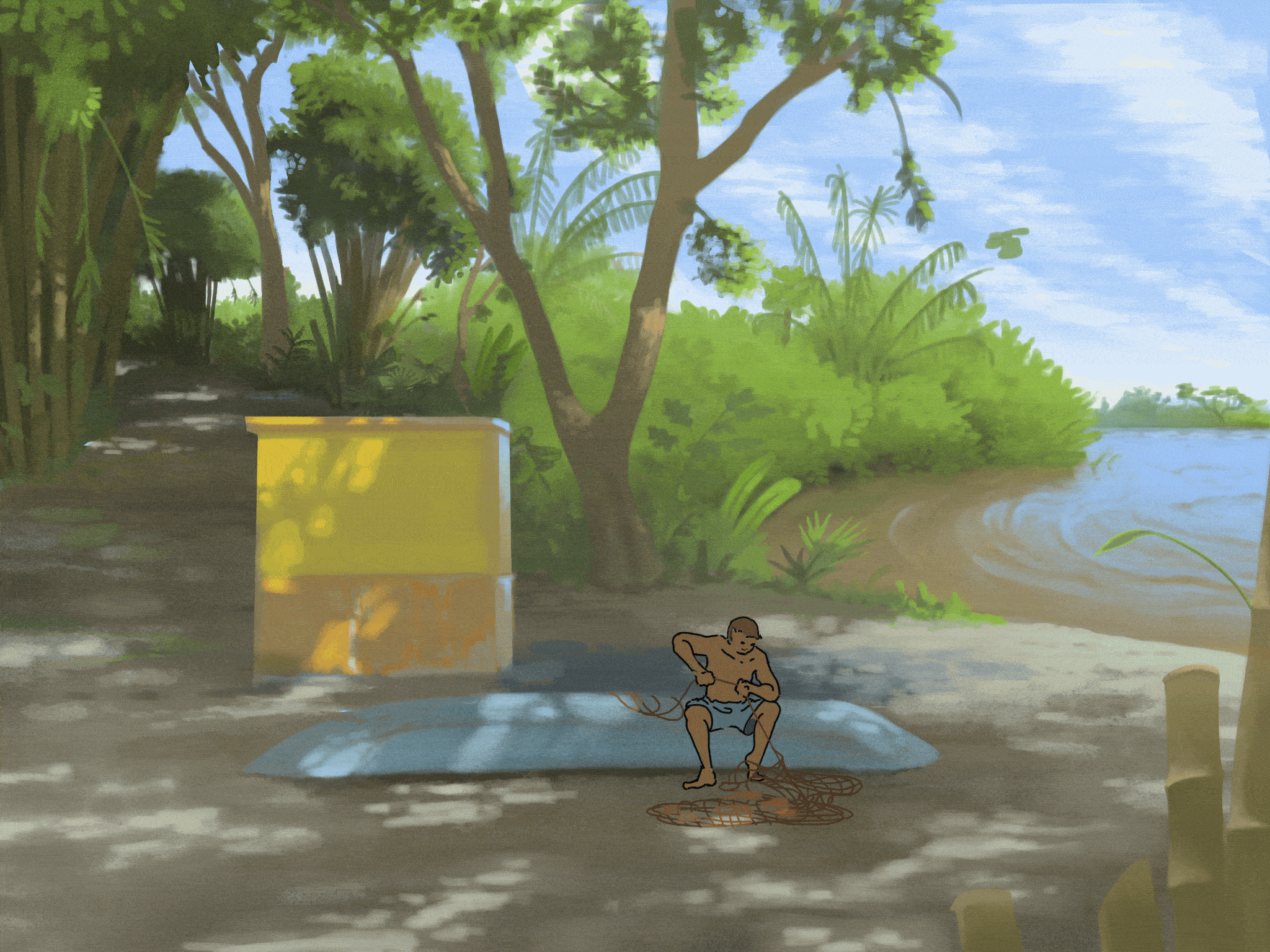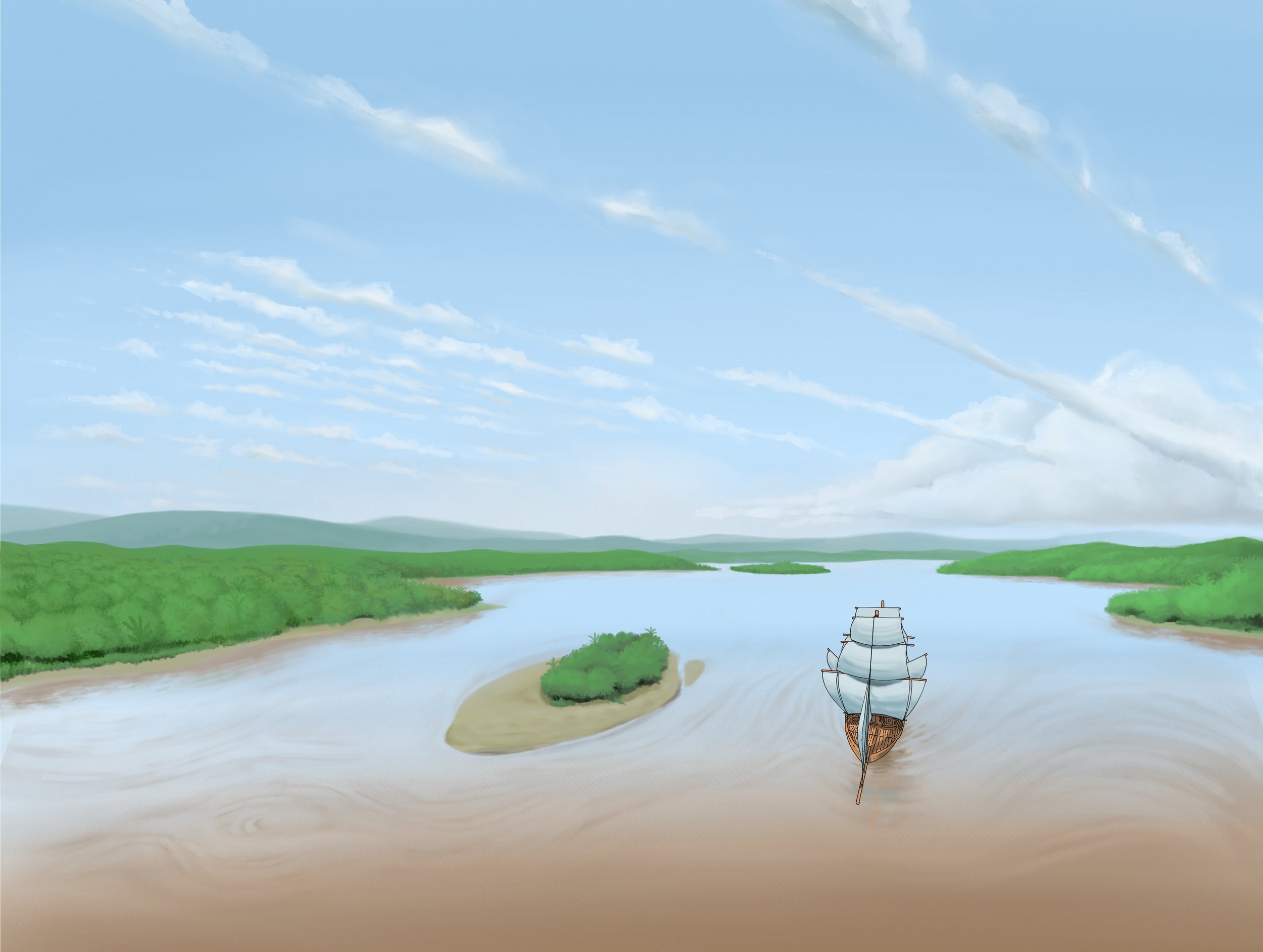Jamie Davis
illustrations Rafael Bonilla
Amanecer. Un Yarumo junto al río Magdalena al amanecer
Sunrise. A Yarumo tree at banks of the Magdalena river at sunrise.
“By other ports, in a lighter boat, you will be brought to shore a different way.” So says Charon the boatman to Dante on the banks of the Acheron, a river which begins near the Greek village of Zatesky, and was thought then to run into Hell, joining the river Styx. Why are rivers and death associated across cultures? Perhaps it is their deep relationship with time. If you think about it, time is built into them. Rivers move. An unmoved river would be a pond or a lake or a puddle. Movement, inevitably towards death, happens in time. Happy trails.
In America we have our own mythic river, the Mississippi; as well as a mythic chronicler of that river, our local Virgil, Samuel Langhorne Clemens, who adopted the nom-de-plume Mark Twain after the MS steamship call that signaled a depth-sounding of two fathoms. The Mississippi, at a length of 2,318 miles and a basin of 1,250,000 square miles, is, according to an 1863 Harper’s Magazine, “the Body of the Nation.” One of the great rivers of the Earth. Steam travel along it revolutionized the American landscape. For the first time, steam allowed travel upriver against strong currents. The ability to transport cotton upriver to the industrial North was essential—along with slavery and the cotton gin—to the cotton boom and the transformation of the pre-Civil War Southern States into a burgeoning agrarian empire. To this day, transport on the river is valued at approximately 400 billion dollars a year.
Twain worked as a riverboat operator, and described this in his memoir Life on the Old Mississippi. Because these early steamships had deep hulls, the shallow waters of the river and their shifting sandbars were treacherous, especially at night and in fog. If the boats ran aground, they could be pulled apart by the strength of the current. So, safe passage on the river necessitated pilots with supernatural memories of every inch of river, as well as the ability to read the surface itself as if it were a book “written in a dead language;” noting the way wind played across it, how the ripples formed, to decipher what lay underneath.
Bergantín por el Magdalena. Los únicos capaces de subir la Magdalena fueron los Bergantines.
Brigantine Over the Magdalena. The only vessels capable of sailing the Magdalena upriver were brigantines.
Constant depth soundings were taken aboard these ships, so that at all points crews would know how close they were to running aground. Pilots memorized each of these measures and where they were taken, dozens every day, and retained those memories through the years. These men lived with a moving river in their heads—a river, that changed its shoals as silt and mud rose and fell with the seasons. Pilots could steer their crafts in the dark, when nights were still as dark as they had been in the beginning of time. They could even pilot the treacherous Mississippi blindfolded, if the need arose. The river in their heads was not just a surface, but a model of the dark laminar flows of the dark kingdom beneath.
If you will take the longest street in New York, and travel up and down it, conning its features patiently until you know every house and window and door and lamp-post and big and little sign by heart, and know them so accurately that you can instantly name the one you are abreast of when you are set down at random in that street in the middle of an inky black night, you will then have a tolerable notion of the amount and the exactness of a pilot's knowledge who carries the Mississippi River in his head. And then if you will go on until you know every street crossing, the character, size, and position of the crossing-stones, and the varying depth of mud in each of those numberless places, you will have some idea of what the pilot must know in order to keep a Mississippi steamer out of trouble. Next, if you will take half of the signs in that long street, and change their places once a month, and still manage to know their new positions accurately on dark nights, and keep up with these repeated changes without making any mistakes, you will understand what is required of a pilot's peerless memory by the fickle Mississippi.
-Mark Twain, Life on the Old Mississippi, 1883
Ciénaga plateada. El plateado no es el reflejo de la tormenta en el río, son los metales pesados como el flúor que ahora plagan sus aguas.
Silver Marsh. The silver color is not the reflection of the storm on the river’s surface. It is the heavy metals, such as fluorine, that now plague the river’s waters.
In ancient Egyptian mythology, the sun god was carried on his barge across the sky from sunrise to sunset. When there was no more sky left to traverse, night fell on Earth and Ra descended to the underworld, where he traveled down the river of the dead. This underworld, the Duat, was composed of the body of the god Osiris. The landscape was the god’s embalmed corpse. When Egyptians died on Earth, they awoke here, surrounded by perilous geographical features and monsters hungry for human flesh. If they perished in the Duat, their soul was extinguished for eternity. In order to avoid this true death of the soul, they too had to perform a feat of memory: while living they had to memorize the collection of prayers and incantations, we now call the Egyptian Book of the Dead. These spells would aid them, but by no means guarantee, that they would be able to make their way across the landscape, and reach the river of the dead to join Ra on his barge, and so be taken up with him. This is why The Book of The Dead was transcribed onto burial linens: to be read after death, and it is from these scraps of cloth that the text survives.
At night a paper lantern with a candle in it is fastened on top of the buoy, and this can be seen a mile or more, a little glimmering spark in the waste of blackness. So, in that solid world of darkness, we went creeping down on the light.”
-Mark Twain, Life on the Old Mississippi, 1883
Of course, Mark Twain was not the first to translate the Mississippi into the Nile, as he did most notably in Huckleberry Finn. By the time Huck and Jim sailed through it, Southern Illinois had been known as “Little Egypt” for generations. He wouldn’t be the last either, as the “Mississliffi” makes its way onto the pages of Finnegans Wake, a book with a deep connection to Egyptian mythology. It famously also recycles the riddle which gets put to Huck: “Where was Moses when the candle went out?” (Answer: “Why, he was in the dark! That’s where he was!”)
There are moments in Twain’s writing, past Cairo and Egypt, when we drift far, far down the Acheron until we are someplace else altogether. There is the moment when Huck and Jim lose each other in the fog of the river and can only call back and forth; when Sam Clemens sees the cane fields burning on the plantations at night, and the smoke rolling over the water. . . these are moments when that Nile becomes the river that runs through the underworld, no longer through America, but through the body of Osiris. In Egyptian mythology Osiris lies dead until the rainy season, when the Nile floods. He is the source of the profusion of growth that follows, the great regeneration which is the source of all of Egypt’s agricultural wealth.
Like Huckleberry Finn, the River has no beginning or end. In its beginning, it is not yet the River; in its end, it is no longer the River . . . At what point in its course does the Mississippi become what the Mississippi means? It is both one and many . . . . at the end it merely disappears among its deltas: it is no longer there, but it is still where it was, hundreds of miles to the north.
-T.S. Eliot, Introduction to The Adventures of Huckleberry Finn, 1950
Atarraya enterrada. Existen muchos tipos de atarraya, la arrastrada, la flotante, la picada, la ojona. La diversidad de peces de Karacalí desciende, ya no le dan nombre al río, ahora lo llaman la Magdalena.
Tangled Fishing Net. There are many types of nets, trap nets, drift nets, surrounding nets. The diversity of Karacalí fish has been decreasing. The fish no longer give the river its name, and now it’s called the Magdalena.
Jamie Davies is a graduate of Marlboro College and the NYU Creative Writing MFA. Find him at jamesd@marlboro.edu.
Luis Bonilla is an animator based in Colombia. He is the creator and director of the Karacalí project—a project which revolves around the observation and characterization of the Magdalena River. It seeks to become familiar with the river’s currents, as well as to understand and recognize its previous, current and subsequent inhabitants. The Karacalí project aims to strengthen the bond with the territories we inhabit in order to better understand the environmental problems that beset these territories. For more of Luis’ illustrations see his instagram page @luis_rafael_bonilla.



